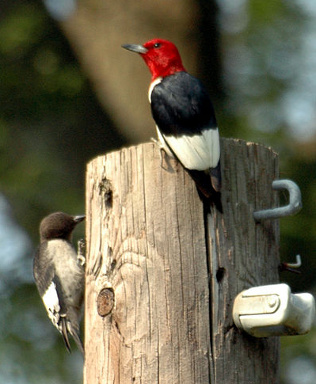 Common Name: Red-Headed Woodpecker
Common Name: Red-Headed Woodpecker
Species Name: Melanerpes erythrocephalus
Description: A vivid red head, neck and breast make the Red-headed Woodpecker easily recognizable. It is an omnivorous species, feeding on insects in the summer and nuts in the winter. Unlike other woodpeckers, the Red-headed Woodpecker forages for food rather than excavating holes to find insects. It is also the only woodpecker that covers up its cache of food with bark or wood. Grasshoppers are stored alive, wedged so tightly into crevices that they can’t escape.
Where it can be found: These birds prefer open woodlands and woodland edges, such as oak savannahs or riparian forests. These habitats contain a higher density of dead trees, which they commonly use for nesting and perching. The bulk of sightings occur east and northeast of Riding Mountain National Park, and north and south of Winnipeg in the communities of Stonewall and Ste. Adolphe, although it is found throughout southern Manitoba
Threats: The Red-headed Woodpecker population has shown a large decrease relative to about 1970. In some areas, birds get killed by being struck on the roads when they are foraging for insects. The removal of dead and dying trees, in which it nests, is also believed to be a significant factor in its decline. Although the population’s future remains uncertain, Manitoba landowners are making a difference by protecting their natural habitat.
Information Sources: Environment Canada, Royal Ontario Museum, WhatBird.com, Wikimedia
Species At Risk Profile: Red-Headed Woodpecker
